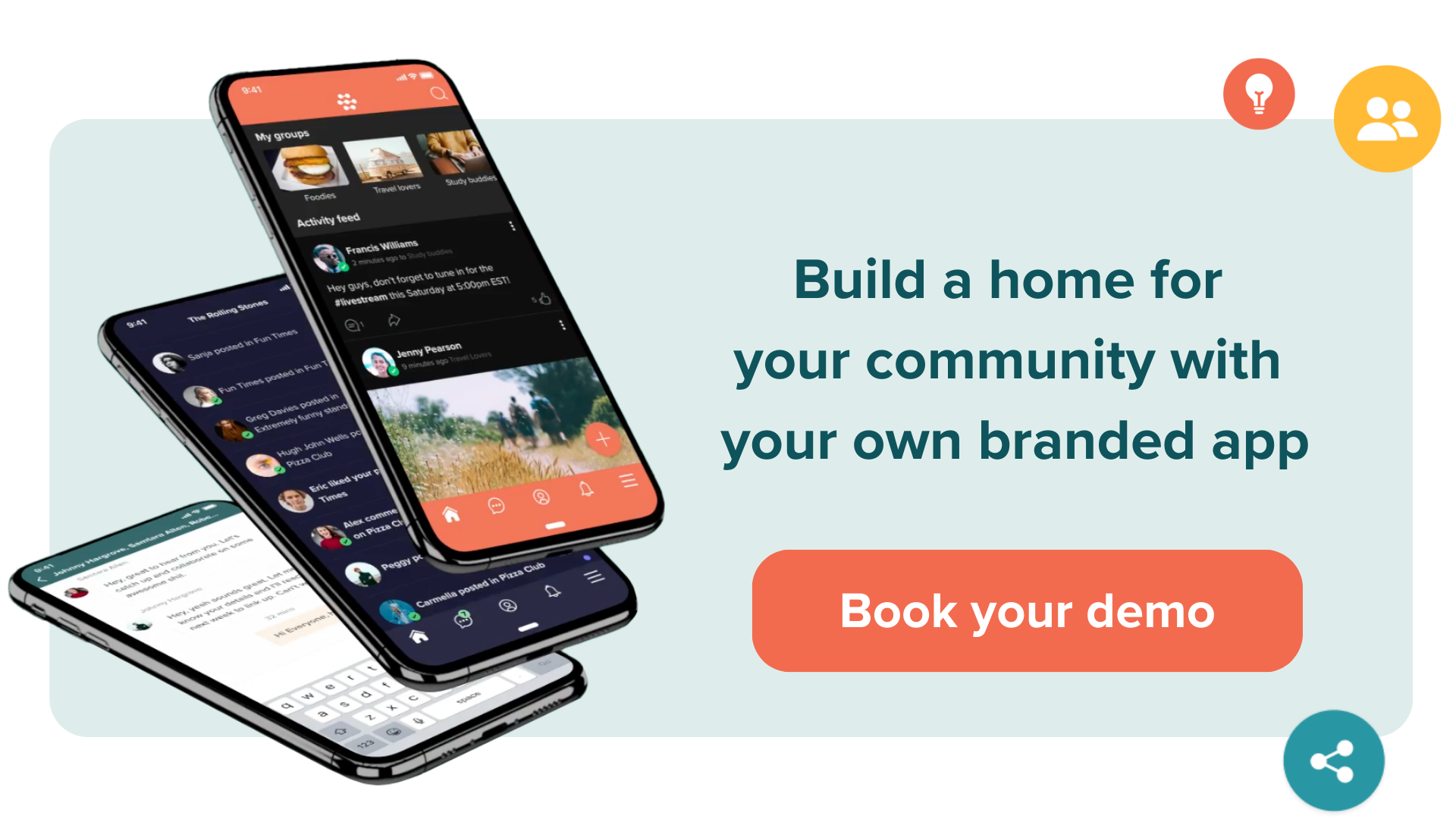Filter by Category
Filter by Category
Contents
Understanding and building a community business model
A community business model enables the magic of human connection to fuel business growth and revenue.
In this digital age, we’re transcending the old brick-and-mortar mindset and knitting together networks of passionate people in digital spaces.
At its core, a community business model isn’t just about transactions; it’s about interactions. It’s the art of transforming conversations and shared interests into a thriving ecosystem that’s as profitable as it is personable. We’re talking about a space where members don’t just consume; they contribute, co-create, and connect.
What makes this model stand out? It taps into the very human need to belong and exchange value, not just in terms of money, but through support, insight, and shared experiences. It’s an arena where every participant is both audience and actor, shaping the community’s journey and, by extension, the success of the business itself.
This is the modern marketplace – diverse, dynamic, and driven by the desire to forge more than just profits, but partnerships and possibilities. Let’s dive in and learn more!
Features of an online community business model
The online community business model is like a garden that grows relationships and opportunities. Here’s how:
- Engagement: It’s the lifeblood of the community. Just like a group chat buzzing with daily updates, an online community thrives on the regular exchange of ideas, feedback, and content. Your communityThese aren’t just passersby; these are your regulars, the ones who pop by not just to see what’s new but to chime in, cheer on, and chip in.
- Exclusivity: This is your VIP lounge in the digital world. Membership offers a golden ticket to a curated experience that’s just for insiders. It’s about creating that special ‘members-only’ jacket feeling, offering content, discussions, and events that aren’t available to just anyone scrolling by.
- Scalability: Think of your community as a megaphone. What starts as a whisper in a small group can amplify across the globe. Online communities aren’t limited by physical seats or the size of a conference hall; they can expand endlessly, reaching people across the globe.
By blending these features, an online community business model creates a world where people feel seen, heard, and valued – and that’s a place where they want to stick around and grow.

10 reasons why more and more businesses are adopting a community business model
From giants like Airbnb to individual coaches, there’s a palpable shift toward community business models, and it’s not hard to see why. They’re not just a trend; they’re a response to a growing demand for authenticity and shared experience in the business world.
Here’s why businesses are increasingly embracing the community way:
1. The power of belonging
- People crave connections. Community business models offer a sense of belonging that goes beyond transactional relationships.
- When customers feel like part of something, their loyalty skyrockets, and they become natural brand ambassadors.
2. Trust translates to transactions
- Communities build trust through transparency and shared values. In an era of skepticism, trust is gold.
- A recommendation from a community member carries more weight than any advertisement.
3. Engagement equals retention
- Engaged customers are happy customers. A vibrant community keeps users coming back for the conversation, not just the product.
- Retention is often more cost-effective than acquisition, making community models financially savvy.
4. Economy of scale
- Online communities allow businesses to scale rapidly. A small local business can become an international community brand without a proportional increase in costs.
- The scalability of community models allows for global reach with a local feel.
5. Crowdsourced innovation
- Communities are hotbeds for innovation, offering a diverse range of insights and ideas.
- Businesses can tap into this resource for product development, leading to offerings that are more likely to meet market needs.
6. Shared values, amplified impact
- Community business models often revolve around shared causes or beliefs. This can amplify a business’s impact on social or environmental issues.
- Consumers increasingly support businesses that stand for something beyond profits.
7. Adaptability in a dynamic market
- Community-led businesses can pivot with agility, guided by real-time feedback from their members.
- This adaptability is critical in a market where consumer preferences and technology evolve at breakneck speed.
8. Digital advantage
- As more of life and commerce move online, community models align naturally with the habits of digital natives.
- Online communities are where conversations happen and decisions are made, making them the perfect place for businesses to engage and grow.
9. The emotional connection
- Emotional connections can create powerful brand loyalty. Communities foster these connections by humanizing businesses and making each member feel seen and heard.
- In a community model, businesses aren’t just selling a product; they’re providing an experience and identity.
10. The network effect
- Communities grow in value as they expand. Each new member increases the network’s value, not just for the business but for every other member.
- This network effect can create exponential growth and brand strength.
Community business models are more than a fleeting trend; they’re a reflection of our innate desire for connection and a strategic response to the evolving landscape of consumer behavior.
By adopting a community-centric approach, businesses can achieve deeper, more meaningful engagement with their audience, leading to a loyal customer base and sustainable growth.

Core metrics for community business success
Now, let’s get practical! In this section, we will look at the factors that make up the nerve center of your community business model. Here, we’re going to unpack the essentials that keep the engine running and the lights on.
Think of this as your community’s health checkup—where we measure vitals like Annual Recurring Revenue (ARR), get a grip on membership fees, monitor the churn rate, and figure out just how much each member pads out your bottom line.
Ready to roll up your sleeves and dive deep? Let’s get into the nitty-gritty of what makes a community business model not just survive, but thrive.
Annual Recurring Revenue (ARR)
ARR isn’t just a fancy acronym; it’s the bread and butter of your community business. Imagine you run a subscription-based fitness community. If each member coughs up $20 a month for access to your exclusive workout videos and forums, and you’ve got 1,000 members, that’s $20,000 per month, or $240,000 a year. Now, that’s your ARR. To boost those numbers:
- Upsell with personalization: Got a member hooked on yoga? Offer them a premium package with exclusive live sessions.
- Refine your offerings: Listen to what your community clamors for, then deliver. More demand can justify a price hike.
- Reduce friction: Make joining a no-brainer. Sleek sign-up processes and diverse payment options are key.
Membership charges
Pricing is like Goldilocks’ porridge: it’s got to be just right. Too high, and you’ll scare people off. Too low, and you’ll undervalue your service. Finding the sweet spot involves:
- Knowing your worth: Research what others are charging. If you’ve got something extra, don’t be shy to price it in.
- Test the waters: Testing is your friend – trial different price points and see what sticks.
- Bundle of joy: People love a good deal. Bundle services together for a price that feels like a steal but still keeps your ledger in the black.
Membership churn
Churn is the arch-nemesis of your ARR. It’s the rate at which folks wave goodbye to your community. The goal? Keep it low. Imagine if out of 100 new members, 10 bail each month. That’s a 10% churn rate, and that’s tough on growth. To plug the leak:
- Engage, engage, engage: The more involved members are, the likelier they are to stick around. Webinars, shoutouts, and community spotlights can keep them engaged.
- Feedback loops: Not feeling the love from some of your members anymore? Ask why. Exit surveys can offer insights you need to make stay-worthy changes.
- Value ladder: Regularly introduce new perks or content to keep the membership fresh and valuable.
Profit per customer
Finally, let’s talk about profit per customer (PPC). This is the average moolah each member brings in. To figure this out, subtract the costs of serving that member from the revenue they generate. If it costs you $5 in resources to maintain a member who pays $20 monthly, your PPC is $15. Crank it up by:
- Cross-sell: Offer related products or services. Think workout gear for our fitness buffs.
- Referral programs: Members can be your best marketers. Offer them incentives to bring in friends.
- Streamline operations: Automate what you can and keep the service costs down.
To wrap this section up, keep these figures under your hat and regularly check on them. They’re the compass that can guide your community business model to the promised land of sustainable profitability.
Blueprint for creating an online community business model
Building an online community business model isn’t just about launching a platform and waiting for people to show up. It’s about crafting a space where engagement and value meet.
Next up, we’re going to walk you through an essential checklist on how to get your community business off the ground and thriving.
1. Niche and value proposition
- Identify your target demographic: Look into market research, survey potential users, and analyze competitors to understand who can benefit most from your community.
- Articulate a clear value proposition: Define what sets your community apart. Host brainstorming sessions, seek feedback from peers, and draft a proposition that resonates with your target audience.
- Validate your concept with potential members: Use tools like social media polls, online surveys, or conduct focus group discussions to see if your community concept piques interest.
2. Platform selection
- Research and compare platform features: Make a list of must-have features, read reviews, and try out demos to find the best fit.
- Test the user experience for ease of use: Have a group of users navigate the platform to ensure it’s intuitive and enjoyable to use.
- Ensure there’s scope for scalability: Plan for future growth by ensuring the platform can handle increased traffic and additional features or services.
Disciple helps businesses build their own beautifully branded apps to enhance their user experience and streamline their operations.
3. Membership guidelines
- Draft community guidelines and policies: Write down the do’s and don’ts, considering legal advice to cover all bases.
- Establish a process for onboarding members: Create welcome materials and a guided process to help new members find their feet quickly.
- Create a system for handling violations: Implement a fair and transparent process for managing and enforcing rules when they are broken.
4. Content strategy
- Map out content themes and types: Plan your content calendar around topics your members care about, using a mix of formats like articles, videos, and infographics.
- Schedule regular content delivery: Use scheduling tools to ensure consistent content release times, keeping your community engaged.
- Plan for member-generated content: Encourage and facilitate community members to create and share their own content to increase engagement and investment.
5. Monetization strategy
- Choose your primary revenue streams: Evaluate different models like membership fees, sponsored content, or affiliate marketing to find what aligns with your community’s values.
- Design a pricing model: Consider the perceived value of your community and member affordability when setting prices.
- Create a balance between free and paid content: Decide what will be freely available and what requires payment, ensuring a mix that satisfies both members and your bottom line.
6. Engagement and participation
- Implement daily engagement tactics: Set up daily prompts, challenges, or discussion topics to keep members coming back.
- Recognize and reward contributors: Highlight member contributions, offer rewards or badges for participation, and make members feel seen and valued.
- Organize regular virtual events or meetups: Plan and host webinars, live Q&As, or online social events to keep the community spirit alive.

7. Growth strategy
- Develop a marketing plan: Craft a strategy that includes content marketing, SEO, and social media advertising to attract new members.
- Set up a referral program: Encourage current members to invite friends by offering them incentives for each new member they bring in.
- Leverage social media for outreach: Utilize social media platforms to share valuable content, interact with potential members, and promote your community.
8. Feedback loop
- Regularly solicit member feedback: Use surveys, suggestion boxes, and direct communication to gather opinions on what’s working and what’s not.
- Monitor community engagement metrics: Keep an eye on analytics like active daily users, time spent on the platform, and discussion thread activity to measure engagement.
- Be open to making iterative improvements: Use feedback and engagement data to continuously refine and improve the community experience.
9. Measuring success and scaling
- Establish key performance indicators (KPIs): Define what success looks like with metrics like member growth rate, engagement levels, and revenue.
- Analyze data for insights into member behavior: Use tools to track your KPIs and understand member habits and preferences.
- Identify opportunities for scaling up: Look for trends in your data that suggest readiness for more advanced features, additional staff, or new market segments.
Remember, a community business model thrives on the collective contribution of its members, so every step you take should aim to bolster that collective spirit.

Conclusion
As we’ve explored throughout this article, the community business model represents more than a mere strategy; it embodies a shift towards inclusivity, sustainability, and mutual growth. By fostering strong relationships with customers and creating an environment where feedback is not only heard but actively sought, businesses can unlock unparalleled levels of engagement and loyalty.
This model isn’t for every entrepreneur or enterprise, but for those who resonate with its principles, the community business model can be a powerful cornerstone for a thriving, purpose-driven business. It asks for a commitment not just to financial objectives but to the values and collective vision shared by the business and its community.
If this resonates with you, then delving into the community business approach might just be the transformative step your business needs to foster a lasting legacy and achieve meaningful success.
As you consider adopting a community business model, it’s vital to choose the right platform to house your community. Disciple stands out as a platform that comprehensively supports the creation and growth of online communities, helping you align your business with the values of inclusivity and mutual growth.
FAQs
What is a community business model?
A community business model is a strategy that businesses use to engage customers and stakeholders in an ongoing dialogue, where their feedback and participation directly influence the business’s products, services, and policies. This model emphasizes building a loyal customer base and creating value that extends beyond financial profits to include social and environmental impact.
How does a community business model differ from traditional business models?
Unlike traditional business models that focus primarily on transactions and revenue, a community business model prioritizes building relationships and fostering a sense of belonging among its customers. It relies on active engagement, collaborative innovation, and shared values to drive business growth and create a lasting impact.
What are the benefits of a community business model?
Benefits include increased customer loyalty, more meaningful brand engagement, innovative ideas from community feedback, diversified revenue streams, and the potential for social and environmental impact. Additionally, community-driven businesses often experience more resilient and sustainable growth.
Can a community business model work for any type of business?
While a community business model can be adapted to many types of businesses, its success largely depends on the business’s willingness to invest in community engagement and the relevance of this model to their customer base and industry. Businesses must evaluate their goals, resources, and customer dynamics to determine if this approach is suitable.
How do I start transitioning my business to a community business model?
Transitioning to a community business model involves several steps, including identifying your core community, developing engagement platforms or forums, establishing community guidelines, and creating feedback mechanisms. It also requires a willingness to adapt business practices based on community input and a long-term commitment to nurturing the community.
See how a Disciple community
can fit your business needs
See how a Disciple community can fit your business needs
Related Articles
18 min read
How To Build Your Online Community From Scratch
Wondering how to create a community? How to turn your social media presence into a thriving online community? …
8 min read
How the Best Businesses Build Brand Communities (+Examples)
No matter the name of your brand, the industry you operate in, the products you make or the …
9 min read






